
Area 51 is a light gun arcade game released by Atari Games in 1995. It takes its name from the military facility. The plot of the game involves the player taking part in a Strategic Tactical Advanced Alien Response (STAAR) military incursion to prevent aliens, known as the Kronn, and alien-created zombies from taking over the Area 51 military facility.

X-Men vs. Street Fighter is a crossover fighting video game developed and published by Capcom. It is Capcom's third fighting game to feature Marvel Comics characters, following X-Men: Children of the Atom and Marvel Super Heroes, and is the first installment in the Marvel vs. Capcom series. As the title suggests, the game includes characters from Marvel's X-Men franchise and the cast from Capcom's Street Fighter series. Originally released as a coin-operated arcade game in 1996, it was ported to the Sega Saturn in 1997 and the PlayStation in 1998.
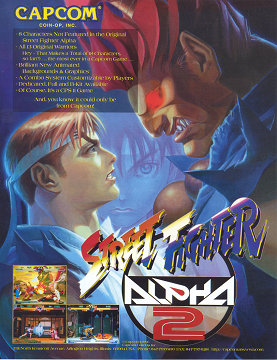
Street Fighter Alpha 2, known as Street Fighter Zero 2 in Japan, Asia, South America, and Oceania, is a 1996 fighting game originally released for the CPS II arcade hardware by Capcom. The game is a remake to the previous year's Street Fighter Alpha: Warriors' Dreams. The game features a number of improvements over the original, such as new attacks, stages, endings, and gameplay features. It was followed by Street Fighter Alpha 3.
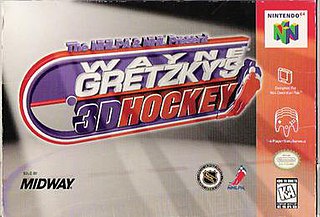
Wayne Gretzky's 3D Hockey is a video game developed and published by Atari Games for the arcade in 1996. A port for the Nintendo 64 console was released almost simultaneously with the arcade version, on November 15, 1996, making it the first-ever 4-player game for the Nintendo 64, beating Mario Kart's Japanese release by more than a month. The game was followed by a sequel, Wayne Gretzky's 3D Hockey '98.

Primal Rage is a fighting game developed and released by Atari Games to arcades in 1994. The game takes place on a post-apocalyptic version of Earth called "Urth". Players control one of seven large beasts that battle each other to determine the planet's fate. Matches feature many of the conventions of fighting games from the era, including special moves and gory finishing maneuvers. Ports were released for home consoles and personal computers. Efforts to perfectly emulate the arcade original have been unsuccessful due to the use of an unusual copy protection method. Toys, comics, a novel and other merchandise tie-ins were produced. More than 1.5 million copies of the game were sold.
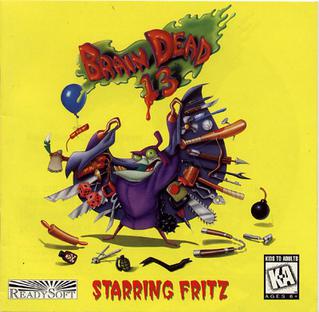
Brain Dead 13 is an interactive movie video game developed and originally published in North America by ReadySoft on 15 December 1995 and in Europe by Empire Interactive on the same year for MS-DOS. Unlike Dragon's Lair and Space Ace, which began as laserdisc arcade games, it was only released for personal computers and video game consoles. In the game, players assume the role of young computer expert Lance Galahad to defeat Dr. Nero Neurosis at his castle and its residents. Its gameplay is primarily presented through the use of full-motion video (FMV).

Marvel Super Heroes is a fighting video game developed by Capcom. Originally released in the arcade in 1995 on the CPS-2 arcade system, it was ported to the Sega Saturn and PlayStation in late 1997. The game, alongside Marvel vs. Capcom: Clash of Super Heroes, was also included in the Marvel vs. Capcom Origins collection, released digitally for the PlayStation 3 and Xbox 360 in September 2012.
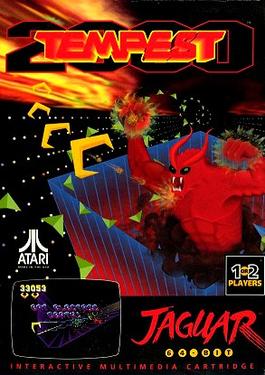
Tempest 2000 is a tube shooter video game originally developed by Llamasoft and published by Atari Corporation for the Atari Jaguar in North America on 13 April, 1994. It was released in Europe on 27 June and in Japan on 15 December of the same year, with the Japanese release being published by Mumin Corporation. Part of Atari Corp.'s 2000 series, it is a remake by Jeff Minter of Dave Theurer's 1981 arcade game Tempest, which used Atari's QuadraScan vector color display technology.
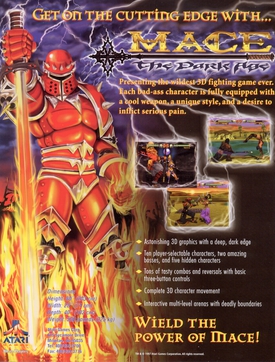
Mace: The Dark Age is a fighting video game released by Atari Games for arcade machines in 1997 and later ported by Midway Games to the Nintendo 64. Like many fighting games of the time, its style is marked by extreme violence, with characters graphically slaying defeated opponents. Utilizing 3dfx Voodoo chips for the hardware, the game received attention for its cutting-edge graphics and turned Atari a profit in the arcades. Critical response to the gameplay was much less enthusiastic.
Namco Museum is a series of video game compilations developed and published by Bandai Namco Entertainment for home video game consoles. The first title in the series, Namco Museum Vol. 1, was released for the PlayStation in 1995. Entries in the series have been released for multiple platforms, including the Game Boy Advance, PlayStation 2, PlayStation Portable, Nintendo DS and Xbox 360. the latest being Namco Museum Archives Vol. 2, released in 2020.

Dungeons & Dragons: Tower of Doom, published in 1994, is the first of two arcade games created by Capcom based on the Dungeons & Dragons tabletop role-playing game and set in the Mystara campaign setting. It is a side scrolling beat 'em up with some role-playing video game elements for one to four players. The game was also released on the Sega Saturn, packaged with its sequel, Dungeons & Dragons: Shadow over Mystara, under the title Dungeons & Dragons Collection, although the Saturn version limited the gameplay to only two players. In 2013, both games were re-released for modern platforms as Dungeons & Dragons: Chronicles of Mystara.

Tetris Plus is a puzzle video game developed and by Jaleco for arcades in 1996, and ported to the Sega Saturn, PlayStation, and Game Boy later that year. The game would be followed by a sequel, Tetris Plus 2, in 1997. Ports were to be developed for the Atari Jaguar and Nintendo 64 but these were never released.

Batman Forever: The Arcade Game is a beat 'em up video game based on the movie Batman Forever. The subtitle is used to differentiate it from Batman Forever, another beat 'em up published by Acclaim at around the same time. One or two players, playing as Batman and Robin, fight Two-Face, the Riddler, and numerous henchmen.

Maximum Force is a light gun shooter arcade game developed by Mesa Logic for Atari Games in 1997. In 1998, Atari Games re-released the game as part of one machine called Area 51/Maximum Force Duo that also included Area 51, and later ported the game to both the Sony PlayStation and Sega Saturn game consoles.

Williams Arcade's Greatest Hits is a video game anthology for the Super Nintendo Entertainment System, PlayStation, Sega Genesis, Saturn, Game.com, Dreamcast, MS-DOS, and Microsoft Windows. The IBM PC compatible and game.com versions are titled Williams Arcade Classics, while the Saturn version was titled Midway Presents Arcade's Greatest Hits. The 2000 release Midway's Greatest Arcade Hits Vol. 1 contains much of the same content.

Street Fighter Collection is a fighting game compilation developed and published by Capcom for the Sega Saturn and PlayStation. It contains the original Super Street Fighter II: The New Challengers (1993), its follow-up Super Street Fighter II Turbo (1994), and an enhanced version of Street Fighter Alpha 2 titled Street Fighter Alpha 2 Gold (1996) [titled Street Fighter Zero 2 Dash in Japan and Street Fighter Alpha 2 Prime in Europe], which is exclusive to this compilation.

The PlayStation Mouse is an input device for the PlayStation that allows the player to use a mouse as a method of control in compatible games. The mouse was released in Japan on December 3, 1994, the launch date of the PlayStation.

NBA Live 97 is the third installment of the NBA Live video games series. The cover features Mitch Richmond of the Sacramento Kings. The game was developed by EA Sports and released in 1996. The MS-DOS, Sega Saturn and PlayStation versions featured polygonal models for the on-court players, thus marking it as the first 3D EA Sports Basketball sequel for the series. It was also the first NBA Live released for the Sega Saturn. The game received mostly positive reviews for its advanced graphics and wide array of available moves and plays, though the Saturn conversion was reviled for numerous technical deficiencies. NBA Live 97 is followed by NBA Live 98.

Shockwave Assault is a science fiction combat flight simulation video game developed by Advanced Technology Group and published by Electronic Arts for various home video game consoles and PCs. The player takes control of a futuristic fighter plane to defeat extraterrestrial ships and tripods.

Arcade's Greatest Hits: The Midway Collection 2 is a compilation of arcade games either made by, or acquired by Midway Games for the Sony PlayStation and Microsoft Windows. This game is technically the sequel to Williams Arcade's Greatest Hits, which also had Midway acquired games included, also released on the PlayStation.


















